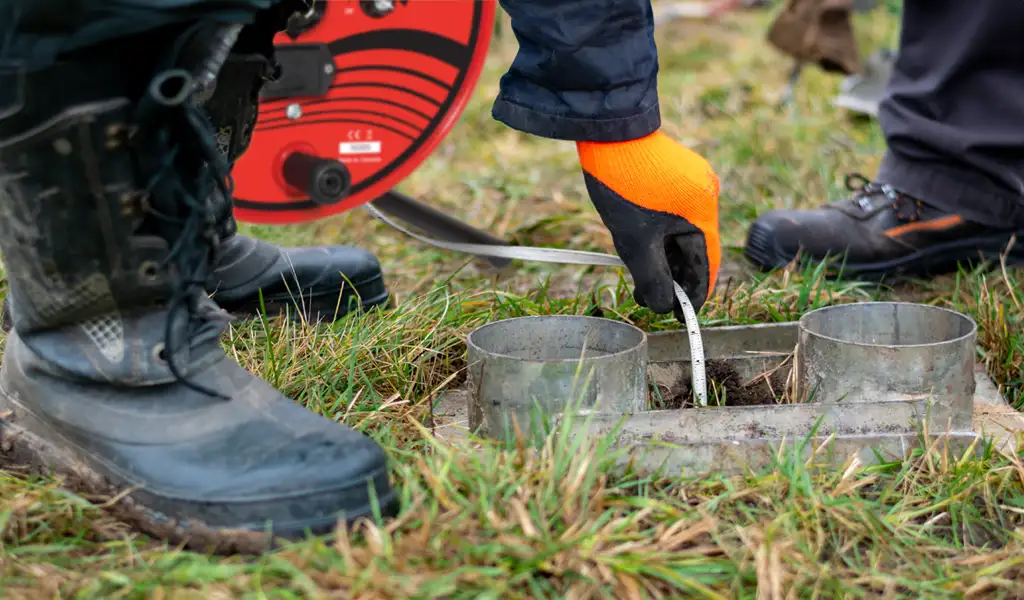Groundwater Monitoring
- What is groundwater?
- Why is groundwater important to monitor?
- Groundwater monitoring applications
- Groundwater Level Measurement
- Solinst Water Level Measurement Devices
- Monitor Water Levels Inside These Instruments
- Groundwater Sampling
- Groundwater Sampling Instruments
- Sample Groundwater Inside These Instruments

What is groundwater?
Groundwater can be found, generally everywhere. Its location can be very deep within the cracks and connected spaces of bedrock or shallow, occupying the pore spaces around the soil particles. It can even gush from the ground as flowing water from wells.
If groundwater can be pumped at a sustainable rate to meet someone's needs, we give it the term "aquifer". This generally means that either the soil or bedrock is considered to be "permeable". If groundwater is present but moves at a slow speed (or rate), we call these geological materials "impermeable".
Groundwater is found in two hydrogeological conditions - unconfined or confined. Unconfined is where there is no upper confining layer. If an impermeable layer is present (this layer can be above and below the aquifer), then the term confining is used.
Groundwater is replenished through the hydrological cycle by snowmelt and rainfall. Maintaining a sustainable 'water balance' so the resource is not over-used is key.
An observation well is used to determine the water level within a particular unit. When an array of observation wells are installed within a confined aquifer, and the depth to water is measured and plotted, the result is a graphical representation of the hydraulic gradient. Hydrogeologists refer to this as a map of the potentiometric surface. In an unconfined aquifer, this plot of the hydraulic gradient is called the water table or phreatic surface.
Why is groundwater important to monitor?
Most of our drinking water comes from groundwater. With less than 1% of the earth's total amount of water being groundwater, this is the most valuable resource on the planet!
Groundwater is a major source the world's freshwater supply, and is constantly under pressure from industrial and urban growth, and agricultural purposes. With scarcity concerns and uncertainty over the effects of climate change, it has become even more important to take stock of current supplies, and to monitor the changes over time.
Worldwide, hydrologists and hydrogeologists study groundwater with a focus to determine the origin, movement, quantity and quality of groundwater. Typically, pumping tests are used to determine the amount of water available, potential recharge rates, and storage potential, and maximum withdrawal acceptable. Continuous and routine depth to water level measurements can monitor groundwater trends and ensure proper stewardship. Groundwater samples are collected and analyzed to measure specific chemical constituents found within the groundwater
Groundwater Monitoring Applications:
- Aquifer characterization:
- pumping tests (slug, bail, constant head, constant flow, step tests, etc), vertical and horizontal flow studies
- Water supply monitoring
- Long-term monitoring in wells
- Tracking impacts of pollutants
- Dewatering
- Salt-water intrusion monitoring
- Monitoring DNAPL and DNAPL sites
- UST investigations
- Remedial assessment studies
- Aquifer Storage and Recovery (ASR) monitoring
- Watershed monitoring

Groundwater Level Measurement
Solinst offers instruments to measure groundwater level, either manually or by automatic datalogging. Solinst also offers telemetry options to connect remote dataloggers to a monitoring network.
Level measurement is important for many reasons. Over-pumping of aquifers causes lowering of the water table, which can cause issues such as land subsidence and saltwater intrusion. Continuous groundwater level monitoring allows: baseline groundwater level data to be obtained, changes in quantity to be tracked over time, identification of trends and pressing issues, and predictions of water levels available in the future. This allows informed groundwater management decisions to be made, improves land-use planning and allows water use programs and policies to be developed. Aquifer characterization provides an understanding of the subsurface hydrological conditions, providing further insight into managing the water source, and where required, allows remediation efforts to be targeted more precisely.
Solinst Water Level Measurement Devices:
- 101 Water Level Meters
- 102 Water Level Meters
- 107 Temperature Level Conductivity Meter
- 122 Interface Meter
- 3001 Levelogger 5
- 3001 Levelogger 5 Junior
- 3001 Levelogger 5 LTC
- 3250 LevelVent 5
- 301 Water Level Temperature Sensor
- 9100 Solinst Telemetry Systems
- 9200 RRL Remote Radio Link
- 9500 LevelSender 5
- 9700 SolSat 5 Satellite Telemetry
Monitor Water Levels Inside These Instruments
- 401 Waterloo Multilevel System
- 403 CMT Multilevel Systems
- 601 Standpipe Piezometers
- 615 Drive-Point Piezometers
- 615ML Multilevel Drive-Point Piezometers
Groundwater Sampling
Water chemistry and quality studies are an integral part of most hydrogeological investigations. Therefore, water samples are collected from monitoring wells, as well as production wells so that water chemistry analysis can be preformed. The goal of groundwater sampling is to collect samples that are representative of actual in-situ conditions, and to maintain sample integrity by minimizing the changes in sample quality and chemistry during collection.
Solinst offers a variety of groundwater sampling options that suit any environment or application, from pumps that provide low flow capabilities, pumps suited to VOC sampling, inexpensive bailers and grab samplers, simple inertial pumps, and a no-purge discrete interval sampler. The samplers come in a variety of materials, including 316 stainless steel, or PVC for sampling corrosive environments or where metals are present. PTFE and polyethylene tubing and bladders are also available. Various depths and pumping rates can be obtained.

Groundwater Sampling Instruments:
- 404 Inertial Pumps
- 407 Bladder Pump
- 408 Double Valve Pump
- 408M Double Valve Pump
- 410 Peristaltic Pump
- 415 12V Submersible Pump
- 425 Discrete Interval Sampler
- 428 BioDegradeable Bailer
- 429 Point Source Bailer

Sample Groundwater Inside These Instruments
- 401 Waterloo Multilevel System
- 403 CMT Multilevel Systems
- 615 Drive-Point Piezometers
- 615ML Multilevel Drive-Point Piezometers
- 601 Standpipe Piezometers



